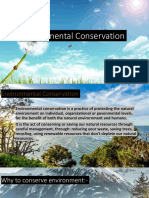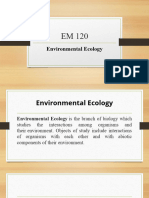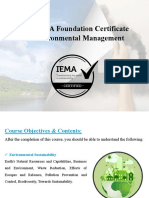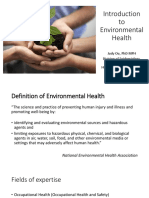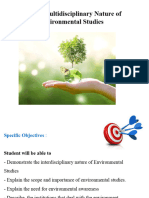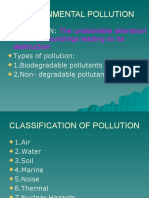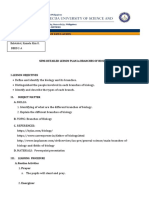0 ratings0% found this document useful (0 votes)
103 viewsLecture 1 Introduction
This document provides an introduction to environmental science. It discusses how environmental science is an interdisciplinary field that draws from various areas of science to study human impacts on the environment. The document outlines the aims and objectives of environmental science, which include understanding and solving environmental problems by studying human use of natural resources and interactions between humans and their environment. A brief history of the emergence of environmental science as a field in response to growing environmental concerns in the 1960s-70s is also provided.
Uploaded by
Vikram MeghCopyright
© © All Rights Reserved
Available Formats
Download as PPTX, PDF, TXT or read online on Scribd
0 ratings0% found this document useful (0 votes)
103 viewsLecture 1 Introduction
This document provides an introduction to environmental science. It discusses how environmental science is an interdisciplinary field that draws from various areas of science to study human impacts on the environment. The document outlines the aims and objectives of environmental science, which include understanding and solving environmental problems by studying human use of natural resources and interactions between humans and their environment. A brief history of the emergence of environmental science as a field in response to growing environmental concerns in the 1960s-70s is also provided.
Uploaded by
Vikram MeghCopyright
© © All Rights Reserved
Available Formats
Download as PPTX, PDF, TXT or read online on Scribd
You are on page 1/ 13
Introduction to Environmental
Science
Dr. Amanullah Mahar
Assistant Professor
Centre for Environmental Science
University of Sindh, Jamshoro
Email: aman.mahar@usindh.edu.pk
1. Introduction
• Our surrounding include forests, rivers,
mountains, desert or combination of these
elements.
• Most of us live in a landscapes that have
been heavily modified by the human
beings in villages, towns, and cities.
• But even those of us who live in cities get
our food supply from surrounding
villages.
• We use water to drink and other day to
day activities, we breath air, and we use
resources from which food is made.
• Our dependence on nature is so great that
we cannot continue to live without
protecting the earths environmental
resources.
2. Definition
Environmental science, interdisciplinary academic field that draws on
ecology, geology, meteorology, biology, chemistry, engineering, and
physics to study environmental problems and human impacts on the
environment.
2. Definition
• Environmental studies incorporates
more of the social sciences for
understanding human relationships,
perceptions and policies towards the
environment.
• Environmental engineering focuses on
design and technology for
improving environmental quality in
every aspect.
• Understanding the earth processes,
evaluating alternative
energy systems, pollution control and
mitigation, natural resource
management, and the effects of global
climate change.
3. The Aim and objectives
One of the major goals of
environmental science is to
understand and to solve
environmental problems. In
order to accomplish this goal,
scientists study two main types
of interactions between humans
and their environment. One area
of focus is on how we use
natural resources, such as water
and plants.
4. Why Environmental Science is important
Environmental science is
important because it enables
you to understand how these
relationships work. For
example, humans breathe out
carbon dioxide, which plants
need for photosynthesis.
Plants are sources of food for
humans and animals. In short,
organisms and humans depend
on each other for survival.
5. History of Environmental Science
• Though the study of the environment is
as old as any human endeavor, the
modern field of environmental science
developed from the growing public
awareness and concern about
environmental problems in the 1960s
and ’70s.
• The publication of books such as Rachel
Carson’s Silent Spring (1962) and Paul
R. Ehrlich’s The Population
Bomb (1968), together with nuclear
proliferation and growing concerns over
the anthropogenic release of toxins and
chemicals, raised awareness about the
need to study the effects of human
actions on the environment.
5. History of Environmental Science
• The burgeoning field of environmental
science took on the task of quantifying
the effects of disasters such as the
1979 Three Mile Island accident or the
impact of atmospheric sulfur
dioxide and other emissions on acid
rain.
• Environmental scientists analyze a wide
variety of environmental problems and
potential solutions,
including alternative
energy systems, pollution control,
and natural resource management,
and may be employed by government,
industry, universities, or nonprofit
organizations.
6. Scope
Environmental Science is a
decision support science,
which has emerged as a result
of convergence of a wide
range of disciplines,
therefore, its scope is wide as
inter and multi-disciplinary
field of knowledge. Its ambit
is as wide as environment
itself.
7. Teaching objectives
• Enable students to learn how to
analyze and assess environmental
problems, its interrelationships with
other systems of the society;
• Equip student with the knowledge
and skill necessary for pollution
abatement, environmental
conservation, management of
natural resources and making path
to sustainable development; and
• To impart skills to carry out
independent scientific and technical
research on various crosscutting
aspects of environmental issues.
8. Course outline (ENVS – 408)
• Basic principles: about convergence of
ecology with economic and sociology to
evolve as environmental science, its
nature, history, scope and the contribution
to society. Environmental aspects: physic-
chemical, biological, socio-economic,
socio-cultural, moral and ethical, and
philosophical thinking.
• Environmental problems: local, regional
and global level. Environmental
challenges: Sustainability of resources for
development: efficiency of energy and
water resources, current and future trends
in growth and resultant environmental
pollution, poverty and resource depletion,
development in industry, agriculture and
urbanization.
9. Recommended books
• Environmental Science: Earth as a Living
Planet, Botkin, D.B & Keller, E.A. 9th Ed.
John Wiley & Sons, 2013.
• Environmental Science: systems and
solutions, McKinney, M.L., Schoch, R.M.
& Yonavjak, L. 5th Ed. Jones & Bartlett
Publishers, 2013
• Environmental Science: Toward a
Sustainable Future, Wright, R.T. & Nebel,
B.J. 10th Ed. Pearson Educational, 2007.
• Environmental Science: working with the
Earth.11th Ed. Miller, G., Tyler. Cengage
Learning, 2005
Thank You
You might also like
- Hourglass Workout Program by Luisagiuliet 276% (21)Hourglass Workout Program by Luisagiuliet 251 pages
- The Hold Me Tight Workbook - Dr. Sue Johnson100% (16)The Hold Me Tight Workbook - Dr. Sue Johnson187 pages
- Read People Like A Book by Patrick King-Edited62% (66)Read People Like A Book by Patrick King-Edited12 pages
- Livingood, Blake - Livingood Daily Your 21-Day Guide To Experience Real Health77% (13)Livingood, Blake - Livingood Daily Your 21-Day Guide To Experience Real Health260 pages
- COSMIC CONSCIOUSNESS OF HUMANITY - PROBLEMS OF NEW COSMOGONY (V.P.Kaznacheev,. Л. V. Trofimov.)94% (212)COSMIC CONSCIOUSNESS OF HUMANITY - PROBLEMS OF NEW COSMOGONY (V.P.Kaznacheev,. Л. V. Trofimov.)212 pages
- Donald Trump & Jeffrey Epstein Rape Lawsuit and Affidavits83% (1016)Donald Trump & Jeffrey Epstein Rape Lawsuit and Affidavits13 pages
- The 36 Questions That Lead To Love - The New York Times94% (34)The 36 Questions That Lead To Love - The New York Times3 pages
- The 36 Questions That Lead To Love - The New York Times95% (21)The 36 Questions That Lead To Love - The New York Times3 pages
- Jeffrey Epstein39s Little Black Book Unredacted PDF75% (12)Jeffrey Epstein39s Little Black Book Unredacted PDF95 pages
- The 4 Hour Workweek, Expanded and Updated by Timothy Ferriss - Excerpt23% (954)The 4 Hour Workweek, Expanded and Updated by Timothy Ferriss - Excerpt38 pages
- Admission Test (Sample Question Paper) : (Section-A (English) )No ratings yetAdmission Test (Sample Question Paper) : (Section-A (English) )3 pages
- Lesson 2 - Ecological Dynamics and ConceptsNo ratings yetLesson 2 - Ecological Dynamics and Concepts68 pages
- THE Biosphere and Its Natural ResourcesNo ratings yetTHE Biosphere and Its Natural Resources28 pages
- ENV1 Chapter 1 The Environmental Dilemmas We FaceNo ratings yetENV1 Chapter 1 The Environmental Dilemmas We Face45 pages
- Ecology Lab - Experiment 6 - Measuring Diversity (Corrected)No ratings yetEcology Lab - Experiment 6 - Measuring Diversity (Corrected)28 pages
- Lecture On Biodiversity: Introduction To Environmental Science100% (1)Lecture On Biodiversity: Introduction To Environmental Science70 pages
- Addis Ababa University: Course: Environmental PlanningNo ratings yetAddis Ababa University: Course: Environmental Planning80 pages
- Chapter 7 - Environmental Audit and Environmental Impact Assesment (Eia)No ratings yetChapter 7 - Environmental Audit and Environmental Impact Assesment (Eia)28 pages
- Introduction To Environmental Health LectureNo ratings yetIntroduction To Environmental Health Lecture41 pages
- An Introduction To Ecology and The BiosphereNo ratings yetAn Introduction To Ecology and The Biosphere54 pages
- Environmental Problems, Their Causes, and SustainabilityNo ratings yetEnvironmental Problems, Their Causes, and Sustainability34 pages
- ECOSYSTEM - Components, Energy Flow and Matter CyclingNo ratings yetECOSYSTEM - Components, Energy Flow and Matter Cycling91 pages
- 02 Unit I Environmental Studies-A Multidisciplinary Subject 14-01-2022No ratings yet02 Unit I Environmental Studies-A Multidisciplinary Subject 14-01-202269 pages
- 1 - Scope and Importance of Environmental Studies100% (1)1 - Scope and Importance of Environmental Studies36 pages
- Impact of Climate Change On BiodiversityNo ratings yetImpact of Climate Change On Biodiversity3 pages
- Landscape Conservation Reclamation and Landscaping of Derelict Lands Environmental Impact Assessment100% (1)Landscape Conservation Reclamation and Landscaping of Derelict Lands Environmental Impact Assessment27 pages
- Food Preservation: Chemical Preservation: Dr. Pradeep PariharNo ratings yetFood Preservation: Chemical Preservation: Dr. Pradeep Parihar30 pages
- Impact of Agricultural Practices On Ecosystem ServicesNo ratings yetImpact of Agricultural Practices On Ecosystem Services36 pages
- Measuring Biodiversity: See The Associated Lesson Plan atNo ratings yetMeasuring Biodiversity: See The Associated Lesson Plan at17 pages
- PNS - BAFS 187.2016.organic Aquaculture FeedsNo ratings yetPNS - BAFS 187.2016.organic Aquaculture Feeds24 pages
- Impact of Water Pollution On Animal Health100% (1)Impact of Water Pollution On Animal Health23 pages
- Causes and Impact of Environmental Degradation: Name: Dhruvika Kokate Roll No: 286 STD: Fybcom Div: 2No ratings yetCauses and Impact of Environmental Degradation: Name: Dhruvika Kokate Roll No: 286 STD: Fybcom Div: 28 pages
- Envi Toxicology Syllabus Sample - Tox 301 Course OutlineNo ratings yetEnvi Toxicology Syllabus Sample - Tox 301 Course Outline4 pages
- Lecture 6 Community-Based Natural Resources ManagementNo ratings yetLecture 6 Community-Based Natural Resources Management10 pages
- MAN0012966 CloneJET PCR Cloning 40rxn UG PDFNo ratings yetMAN0012966 CloneJET PCR Cloning 40rxn UG PDF2 pages
- Advances in Plant Breeding Strategies - Cereals100% (1)Advances in Plant Breeding Strategies - Cereals606 pages
- Temperature Compensation in Ecto, Endo and Heterotherms0% (1)Temperature Compensation in Ecto, Endo and Heterotherms24 pages
- Instant Download Nanostructures for Antimicrobial and Antibiofilm Applications Ram Prasad PDF All Chapters100% (3)Instant Download Nanostructures for Antimicrobial and Antibiofilm Applications Ram Prasad PDF All Chapters55 pages
- Skillful Listening and Speaking Level 3No ratings yetSkillful Listening and Speaking Level 311 pages
- Science 10 A2.1 Overview of The Endocrine SystemNo ratings yetScience 10 A2.1 Overview of The Endocrine System34 pages
- Livingood, Blake - Livingood Daily Your 21-Day Guide To Experience Real HealthLivingood, Blake - Livingood Daily Your 21-Day Guide To Experience Real Health
- COSMIC CONSCIOUSNESS OF HUMANITY - PROBLEMS OF NEW COSMOGONY (V.P.Kaznacheev,. Л. V. Trofimov.)COSMIC CONSCIOUSNESS OF HUMANITY - PROBLEMS OF NEW COSMOGONY (V.P.Kaznacheev,. Л. V. Trofimov.)
- Donald Trump & Jeffrey Epstein Rape Lawsuit and AffidavitsDonald Trump & Jeffrey Epstein Rape Lawsuit and Affidavits
- The 36 Questions That Lead To Love - The New York TimesThe 36 Questions That Lead To Love - The New York Times
- The 36 Questions That Lead To Love - The New York TimesThe 36 Questions That Lead To Love - The New York Times
- Jeffrey Epstein39s Little Black Book Unredacted PDFJeffrey Epstein39s Little Black Book Unredacted PDF
- The 4 Hour Workweek, Expanded and Updated by Timothy Ferriss - ExcerptThe 4 Hour Workweek, Expanded and Updated by Timothy Ferriss - Excerpt
- Admission Test (Sample Question Paper) : (Section-A (English) )Admission Test (Sample Question Paper) : (Section-A (English) )
- Ecology Lab - Experiment 6 - Measuring Diversity (Corrected)Ecology Lab - Experiment 6 - Measuring Diversity (Corrected)
- Lecture On Biodiversity: Introduction To Environmental ScienceLecture On Biodiversity: Introduction To Environmental Science
- Addis Ababa University: Course: Environmental PlanningAddis Ababa University: Course: Environmental Planning
- Chapter 7 - Environmental Audit and Environmental Impact Assesment (Eia)Chapter 7 - Environmental Audit and Environmental Impact Assesment (Eia)
- Environmental Problems, Their Causes, and SustainabilityEnvironmental Problems, Their Causes, and Sustainability
- ECOSYSTEM - Components, Energy Flow and Matter CyclingECOSYSTEM - Components, Energy Flow and Matter Cycling
- 02 Unit I Environmental Studies-A Multidisciplinary Subject 14-01-202202 Unit I Environmental Studies-A Multidisciplinary Subject 14-01-2022
- Landscape Conservation Reclamation and Landscaping of Derelict Lands Environmental Impact AssessmentLandscape Conservation Reclamation and Landscaping of Derelict Lands Environmental Impact Assessment
- Food Preservation: Chemical Preservation: Dr. Pradeep PariharFood Preservation: Chemical Preservation: Dr. Pradeep Parihar
- Impact of Agricultural Practices On Ecosystem ServicesImpact of Agricultural Practices On Ecosystem Services
- Measuring Biodiversity: See The Associated Lesson Plan atMeasuring Biodiversity: See The Associated Lesson Plan at
- Causes and Impact of Environmental Degradation: Name: Dhruvika Kokate Roll No: 286 STD: Fybcom Div: 2Causes and Impact of Environmental Degradation: Name: Dhruvika Kokate Roll No: 286 STD: Fybcom Div: 2
- Envi Toxicology Syllabus Sample - Tox 301 Course OutlineEnvi Toxicology Syllabus Sample - Tox 301 Course Outline
- Lecture 6 Community-Based Natural Resources ManagementLecture 6 Community-Based Natural Resources Management
- Industrial Applications of Soil Microbes: Volume 1From EverandIndustrial Applications of Soil Microbes: Volume 1
- Temperature Compensation in Ecto, Endo and HeterothermsTemperature Compensation in Ecto, Endo and Heterotherms
- Instant Download Nanostructures for Antimicrobial and Antibiofilm Applications Ram Prasad PDF All ChaptersInstant Download Nanostructures for Antimicrobial and Antibiofilm Applications Ram Prasad PDF All Chapters




































